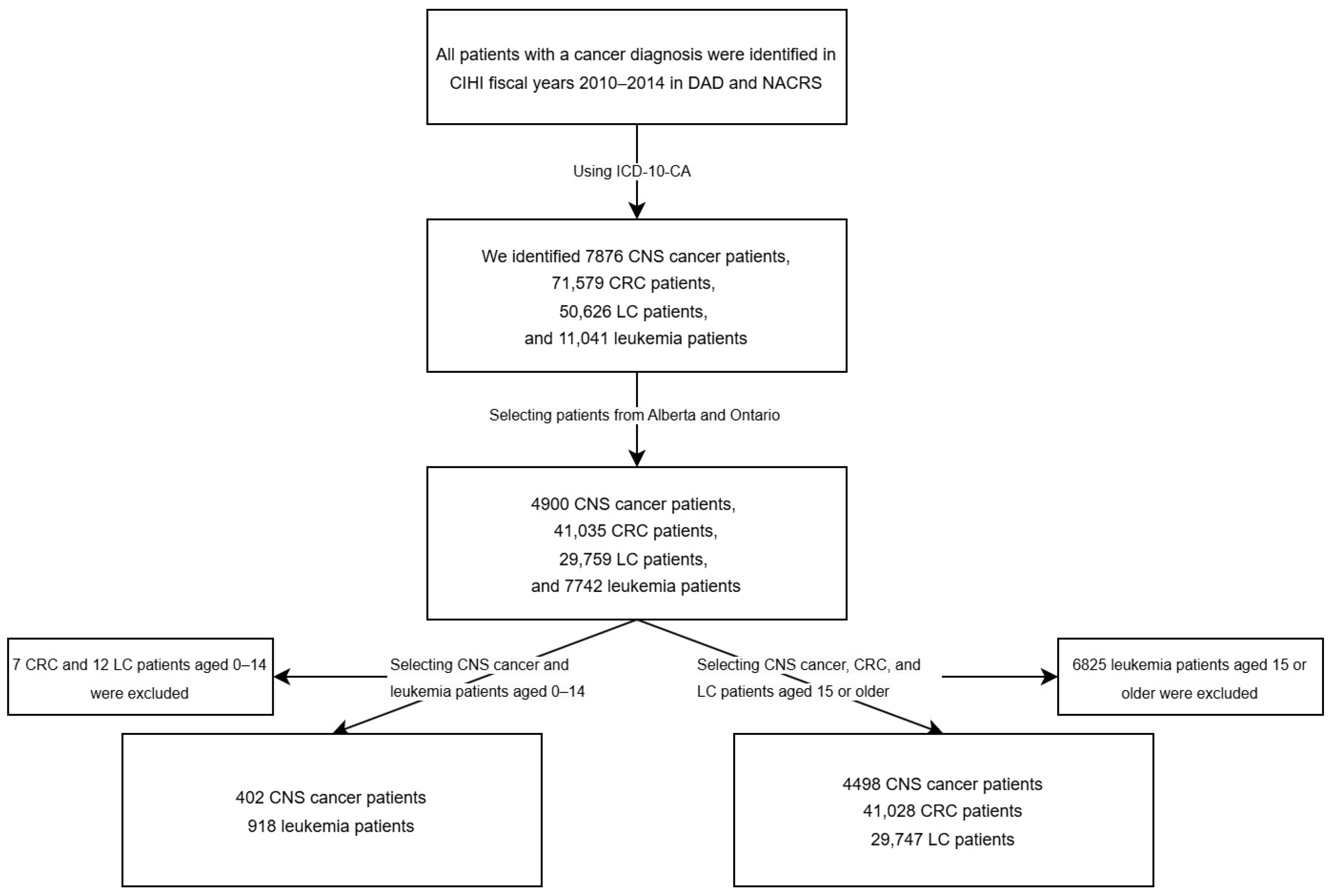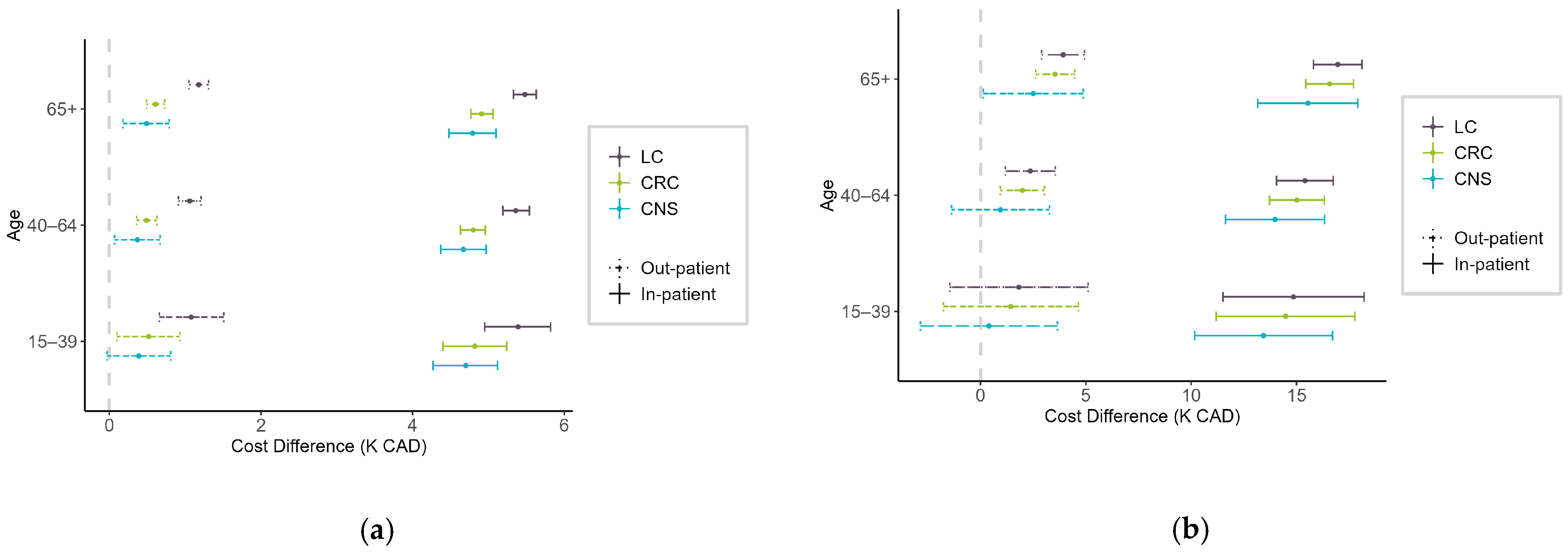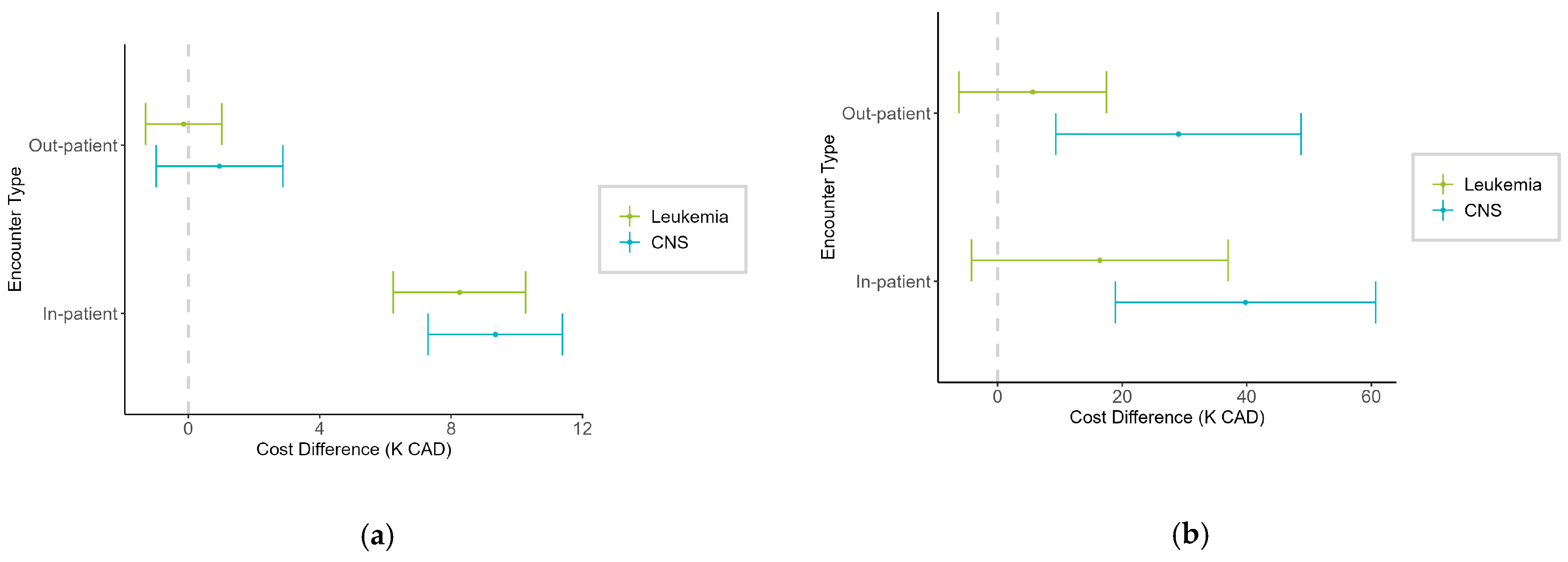Understanding Diagnostic Costs Using Hospital-Based Encounters in the Year Before Diagnosis for Canadian Patients with Malignant Central Nervous System Tumours Compared to Common Cancers
Abstract
1. Introduction
2. Methods
2.1. Data Coverage and Datasets
2.2. Patient Selection
2.3. Pre-Diagnostic Healthcare Expenditure Calculation
2.4. Data Analysis
3. Results
3.1. Cost of Patients with CNS vs. CRC/LC
3.1.1. Patient Characteristics
3.1.2. Quantile Analysis
3.2. Cost of Pediatric Patients with CNS vs. Leukemia
3.2.1. Patient Characteristics
3.2.2. Quantile Analysis
4. Discussion
5. Conclusions
Author Contributions
Funding
Institutional Review Board Statement
Informed Consent Statement
Data Availability Statement
Conflicts of Interest
References
- Gatta, G.; Van Der Zwan, J.M.; Casali, P.G.; Siesling, S.; Dei Tos, A.P.; Kunkler, I.; Otter, R.; Licitra, L.; Mallone, S.; Tavilla, A.; et al. Rare Cancers Are Not so Rare: The Rare Cancer Burden in Europe. Eur. J. Cancer 2011, 47, 2493–2511. [Google Scholar] [CrossRef] [PubMed]
- Greenlee, R.T.; Goodman, M.T.; Lynch, C.F.; Platz, C.E.; Havener, L.A.; Howe, H.L. The Occurrence of Rare Cancers in US Adults, 1995–2004. Public Health Rep. 2010, 125, 25–43. [Google Scholar] [CrossRef]
- Walker, E.V.; Maplethorpe, E.; Davis, F.G. Rare Cancers in Canada, 2006–2016: A Population-Based Surveillance Report and Comparison of Different Methods for Classifying Rare Cancers. Cancer Epidemiol. 2020, 67, 101721. [Google Scholar] [CrossRef] [PubMed]
- Christyani, G.; Carswell, M.; Qin, S.; Kim, W. An Overview of Advances in Rare Cancer Diagnosis and Treatment. Int. J. Mol. Sci. 2024, 25, 1201. [Google Scholar] [CrossRef]
- Walker, E.V.; Zhou, Y.; Wu, Y.; Liu, J.; Climans, S.A.; Davis, F.G.; Yuan, Y. The Incidence and Prevalence of Primary Central Nervous System (CNS) Tumours in Canada (2010–2017), and the Survival of Patients Diagnosed with CNS Tumours (2008–2017). Curr. Oncol. 2023, 30, 4311–4328. [Google Scholar] [CrossRef] [PubMed]
- Louis, D.N.; Ohgaki, H.; Wiestler, O.D.; Cavenee, W.K.; Burger, P.C.; Jouvet, A.; Scheithauer, B.W.; Kleihues, P. The 2007 WHO Classification of Tumours of the Central Nervous System. Acta Neuropathol. 2007, 114, 97–109. [Google Scholar] [CrossRef]
- Louis, D.N.; Perry, A.; Reifenberger, G.; von Deimling, A.; Figarella-Branger, D.; Cavenee, W.K.; Ohgaki, H.; Wiestler, O.D.; Kleihues, P.; Ellison, D.W. The 2016 World Health Organization Classification of Tumors of the Central Nervous System: A Summary. Acta Neuropathol. 2016, 131, 803–820. [Google Scholar] [CrossRef] [PubMed]
- Louis, D.N.; Perry, A.; Wesseling, P.; Brat, D.J.; Cree, I.A.; Figarella-Branger, D.; Hawkins, C.; Ng, H.K.; Pfister, S.M.; Reifenberger, G.; et al. The 2021 WHO Classification of Tumors of the Central Nervous System: A Summary. Neuro Oncol. 2021, 23, 1231–1251. [Google Scholar] [CrossRef] [PubMed]
- Canadian Institute for Health Information. Data Available by Year and Jurisdictional Coverage. Available online: https://www.cihi.ca/sites/default/files/document/data-availability-and-jurisdictional-coverage-en.xlsx (accessed on 2 September 2024).
- Canadian Institute for Health Information. International Statistical Classification of Diseases and Related Health Problems, Tenth Revision, Canada (ICD-10-CA): Alphabetical Index and Tabular List; Canadian Institute for Health Information: Ottawa, ON, Canada, 2022; ISBN 9781774791028. [Google Scholar]
- Canadian Institute for Health Information. Data Quality Documentation, Discharge Abstract Database—Multi-Year Information. Available online: https://www.cihi.ca/sites/default/files/dad_multi-year_en_0.pdf (accessed on 8 January 2025).
- Canadian Institute for Health Information. Data Quality Documentation, National Ambulatory Care Reporting System—Multi-Year Information. Available online: https://www.cihi.ca/sites/default/files/nacrs_multi-year_info_en_0.pdf (accessed on 8 January 2025).
- Canadian Cancer Statistics. Canadian Cancer Statistics Dashboard (CCSD). Available online: https://cancerstats.ca/ (accessed on 19 January 2025).
- Canadian Cancer Society. Childhood Leukemia Statistics. Available online: https://cancer.ca/en/cancer-information/cancer-types/leukemia-childhood/statistics (accessed on 19 January 2025).
- Cortez-Pinto, J.; Claro, I.; Francisco, I.; Lage, P.; Filipe, B.; Rodrigues, P.; Chaves, P.; Albuquerque, C.; Dias Pereira, A. Pediatric Colorectal Cancer: A Heterogenous Entity. J. Pediatr. Hematol. Oncol. 2020, 42, 131–135. [Google Scholar] [CrossRef] [PubMed]
- Youlden, D.R.; Foresto, S.A.; Aitken, J.F. Primary Malignant Lung Tumors in Children: A Report from the Australian Childhood Cancer Registry, 1983-2015. Pediatr. Pulmonol. 2020, 55, 719–722. [Google Scholar] [CrossRef] [PubMed]
- Thierheimer, M.; Cioffi, G.; Waite, K.A.; Kruchko, C.; Quinn, Q.T.; Barnholtz-Sloan, J.S. Mortality Trends in Primary Malignant Brain and Central Nervous System Tumors Vary by Histopathology, Age, Race, and Sex. J. Neurooncol. 2023, 162, 167–177. [Google Scholar] [CrossRef]
- Halfon, P.; Eggli, Y.; van Melle, G.; Chevalier, J.; Wasserfallen, J.B.; Burnand, B. Measuring Potentially Avoidable Hospital Readmissions. J. Clin. Epidemiol. 2002, 55, 573–587. [Google Scholar] [CrossRef] [PubMed]
- Quan, H.; Sundararajan, V.; Halfon, P.; Fong, A.; Burnand, B.; Luthi, J.-C.; Saunders, L.D.; Beck, C.A.; Feasby, T.E.; Ghali, W.A. Coding Algorithms for Defining Comorbidities in ICD-9-CM and ICD-10 Administrative Data. Med. Care 2005, 43, 1130–1139. [Google Scholar] [CrossRef] [PubMed]
- Koenker, R. Quantile Regression; Cambridge University Press: Cambridge, UK, 2005. [Google Scholar]
- de Oliveira, C.; Bremner, K.E.; Liu, N.; Greenberg, M.L.; Nathan, P.C.; McBride, M.L.; Krahn, M.D. Costs of Cancer Care in Children and Adolescents in Ontario, Canada. Pediatr. Blood Cancer 2017, 64, e26628. [Google Scholar] [CrossRef] [PubMed]
- de Oliveira, C.; Bremner, K.E.; Pataky, R.; Gunraj, N.; Chan, K.; Peacock, S.; Krahn, M.D. Understanding the Costs of Cancer Care before and after Diagnosis for the 21 Most Common Cancers in Ontario: A Population-Based Descriptive Study. Can. Med. Assoc. Open Access J. 2013, 1, E1–E8. [Google Scholar] [CrossRef] [PubMed]
- Ellison, L.F.; Saint-Jacques, N. Five-Year Cancer Survival by Stage at Diagnosis in Canada. Health Rep. 2023, 34, 3–15. [Google Scholar] [CrossRef] [PubMed]
- Canadian Cancer Statistics Advisory Committee in Collaboration with the Canadian Cancer Society, Statistics and the Public Health Agency of Canada. Canadian Statistics 2023; Canadian Cancer Society: Toronto, ON, Canada, 2023; Available online: https://cdn.cancer.ca/-/media/files/research/cancer-statistics/2023-statistics/2023_PDF_EN.pdf (accessed on 4 November 2024).
- Walker, E.V.; Liu, J.; Davis, F.G.; Climans, S.; Yuan, Y. Brain Tumour Registry of Canada (BTRC): Survival and Prevalence Report 2010–2017. Available online: https://braintumourregistry.ca/wp-content/uploads/2022/06/Brain-Tumour-Registry-of-Canada-Final-Survival-and-Prevalence-Report-June-2022.pdf (accessed on 4 November 2024).
- Cancer Care Alberta. The 2024 Report on Cancer Statistics in Alberta (ROCSIA). Available online: https://public.tableau.com/app/profile/cancercontrol.ab/viz/The2024ReportonCancerStatisticsinAlberta/Highlights (accessed on 4 November 2024).
- Cancer Care Ontario. Ontario Cancer Statistics 2022. Available online: https://www.cancercareontario.ca/en/data-research/view-data/statistical-reports/ontario-cancer-statistics-2022 (accessed on 4 November 2024).
- Health Canada. Canada’s Health Care System. Available online: https://www.canada.ca/en/health-canada/services/health-care-system/reports-publications/health-care-system/canada.html (accessed on 2 September 2024).






| Central Nervous System | Colorectal | Lung | |||||||
|---|---|---|---|---|---|---|---|---|---|
| N (%) | Cost 50p | Cost 90p | N (%) | Cost 50p | Cost 90p | N (%) | Cost 50p | Cost 90p | |
| Overall | 4498 | 6.2 | 24.0 | 41,028 | 1.5 | 18.3 | 29,747 | 3.1 | 18.7 |
| Province | |||||||||
| Ontario | 3501 (78) | 7.0 | 23.1 | 33,246 (81) | 1.3 | 16.7 | 23,898 (80) | 2.7 | 16.7 |
| Alberta | 997 (22) | 3.9 | 25.6 | 7782 (19) | 2.1 | 23.9 | 5849 (20) | 4.5 | 25.5 |
| Sex | |||||||||
| Female | 2087 (46) | 5.5 | 22.3 | 18,636 (45) | 1.7 | 18.4 | 14,637 (49) | 3.3 | 18.3 |
| Male | 2411 (54) | 7.0 | 25.3 | 22,392 (55) | 1.4 | 18.1 | 15,110 (51) | 2.8 | 19.0 |
| Age | |||||||||
| 15–39 Years | 829 (18) | 8.1 | 21.2 | 865 (2) | 2.0 | 14.9 | 209 (1) | 2.7 | 21.6 |
| 40–64 Years | 2036 (45) | 5.6 | 22.1 | 14,071 (34) | 1.2 | 13.5 | 9340 (31) | 2.7 | 15.9 |
| 65+ Years | 1633 (36) | 6.1 | 27.1 | 26,094 (64) | 1.7 | 21.4 | 20,198 (68) | 3.3 | 20.0 |
| Encounter Type | |||||||||
| In-patient | 2454 (55) | 11.0 | 31.5 | 13,905 (34) | 11.1 | 35.1 | 11,289 (38) | 11.0 | 30.5 |
| Out-patient | 2044 (45) | 0.8 | 7.9 | 27,123 (66) | 0.8 | 3.9 | 18,458 (62) | 1.4 | 6.6 |
| Comorbidity Status | |||||||||
| No | 4204 (93) | 7.6 | 24.7 | 36,232 (88) | 1.7 | 19.1 | 24,469 (82) | 4.3 | 20.3 |
| Yes | 294 (7) | 0.8 | 6.4 | 4796 (12) | 0.9 | 7.3 | 5278 (18) | 1.4 | 7.2 |
| At 50th Percentile | At 90th Percentile | |||
|---|---|---|---|---|
| Characteristic | Coefficient (95% CI) | p-Value | Coefficient (95% CI) | p-Value |
| (Intercept) | 11.4 (11.2, 11.6) | 0.00 | 34.4 (33.0, 35.7) | 0.00 |
| Cancer type | ||||
| Central Nervous System | Ref. | Ref. | ||
| Colorectal | −0.7 (−0.8, −0.5) | 0.00 | −1.1 (−2.5, 0.2) | 0.10 |
| Lung | −0.9 (−1.1, −0.7) | 0.00 | −4.3 (−5.7, −2.9) | 0.00 |
| Province | ||||
| Ontario | Ref. | Ref. | ||
| Alberta | 4.8 (4.5, 5.1) | 0.00 | 15.5 (13.2, 17.9) | 0.00 |
| Age | ||||
| 65+ Years | Ref. | Ref. | ||
| 15–39 Years | −1.1 (−1.4, −0.8) | 0.00 | −9.1 (−11.4, −6.9) | 0.00 |
| 40–64 Years | −1.1 (−1.2, −1.0) | 0.00 | −9.0 (−9.8, −8.2) | 0.00 |
| Encounter Type | ||||
| In-patient | Ref. | Ref. | ||
| Out-patient | −10.7 (−11.0, −10.4) | 0.00 | −26.1 (−28.0, −24.2) | 0.00 |
| Comorbidity | ||||
| No | Ref. | Ref. | ||
| Yes | 45.4 (45.0, 46.0) | 0.00 | 109.2 (105.3, 113.1) | 0.00 |
| Cancer Type in Province | ||||
| Central Nervous System in Ontario | Ref. | Ref. | ||
| Colorectal in Alberta | 0.1 (−0.2, 0.4) | 0.42 | 1.0 (−1.3, 3.4) | 0.38 |
| Lung in Alberta | 0.7 (0.4, 1.0) | 0.00 | 1.4 (−1.0, 3.8) | 0.24 |
| Cancer Type in Encounter Type | ||||
| Central Nervous System in In-patient | Ref. | Ref. | ||
| Colorectal in Out-patient | 0.8 (0.5, 1.0) | 0.00 | −3.1 (−5.0, −1.2) | 0.00 |
| Lung in Out-patient | 1.5 (1.2, 1.7) | 0.00 | 2.3 (0.4, 4.3) | 0.02 |
| Age in Province | ||||
| 65+ Years in Ontario | Ref. | Ref. | ||
| 15–39 Years in Alberta | −0.1 (−0.5, 0.3) | 0.65 | −2.1 (−5.3, 1.1) | 0.20 |
| 40–64 Years in Alberta | −0.1 (−0.3, 0.03) | 0.11 | −1.6 (−2.7, −0.4) | 0.01 |
| Encounter Type in Province | ||||
| In-patient in Ontario | Ref. | Ref. | ||
| Out-patient in Alberta | −4.3 (−4.4, −4.2) | 0.00 | −13.0 (−14.2, −12.0) | 0.00 |
| Age in Encounter Type | ||||
| 65+ Years in In-patient | Ref. | Ref. | ||
| 15–39 Years in Out-patient | 1.1 (0.7, 1.5) | 0.00 | 9.0 (6.2, 11.9) | 0.00 |
| 40–64 Years in Out-patient | 1.1 (1.0, 1.2) | 0.00 | 7.2 (6.2, 8.1) | 0.00 |
| Comorbidity in Encounter Type | ||||
| No in In-patient | Ref. | Ref. | ||
| Yes in Out-patient | −45.4 (−46.0, −44.9) | 0.00 | −108.7 (−112.6, −104.7) | 0.00 |
| Central Nervous System | Leukemia | |||||
|---|---|---|---|---|---|---|
| N (%) | Cost 50p | Cost 90p | N (%) | Cost 50p | Cost 90p | |
| Overall | 402 | 5.2 | 58.5 | 918 | 0.7 | 28.7 |
| Province | ||||||
| Ontario | 267 (66) | 5.9 | 41.2 | 593 (65) | 0.8 | 28.7 |
| Alberta | 135 (34) | 3.6 | 68.0 | 325 (35) | 0.7 | 28.2 |
| Sex | ||||||
| Female | 178 (44) | 5.3 | 51.6 | 400 (44) | 0.7 | 30.0 |
| Male | 224 (56) | 4.2 | 72.5 | 518 (56) | 0.7 | 27.5 |
| Encounter Type | ||||||
| In-patient | 217 (54) | 15.6 | 80.7 | 254 (28) | 24.4 | 57.1 |
| Out-patient | 185 (46) | 0.8 | 6.0 | 664 (72) | 0.5 | 2.2 |
| Comorbidity Status | ||||||
| No | 395 (98) | 5.3 | 58.4 | 908 (99) | 0.7 | 28.7 |
| Yes | 7 (2) | 2.1 | 54.8 | 10 (1) | 0.7 | 8.3 |
| Characteristic | At 50th Percentile | At 90th Percentile | ||
|---|---|---|---|---|
| Coefficient (95% CI) | p-Value | Coefficient (95% CI) | p-Value | |
| (Intercept) | 14.3 (13.2, 15.5) | 0.00 | 68.5 (55.9, 81.0) | 0.00 |
| Cancer Type | ||||
| Central Nervous System | Ref. | Ref. | ||
| Leukemia | 7.7 (6.2, 9.2) | 0.00 | −10.8 (−27.2, 5.6) | 0.20 |
| Province | ||||
| Ontario | Ref. | Ref. | ||
| Alberta | 9.6 (7.5, 11.6) | 0.00 | 37.7 (15.1, 60.3) | 0.00 |
| Encounter Type | ||||
| In-patient | Ref. | Ref. | ||
| Out-patient | −13.7 (−15.5, −12.0) | 0.00 | −67.0 (−86.3, −47.8) | 0.00 |
| Cancer Type in Province | ||||
| Central Nervous System in Ontario | Ref. | Ref. | ||
| Leukemia in Alberta | −0.9 (−2.9, 1.2) | 0.41 | −18.5 (−41.3, 4.4) | 0.11 |
| Cancer Type in Encounter Type | ||||
| Central Nervous System in In-patient | Ref. | Ref. | ||
| Leukemia in Out-patient | −7.8 (−9.7, −5.8) | 0.00 | 10.8 (−11.0, 32.7) | 0.33 |
| Encounter Type in Province | ||||
| In-patient in Ontario | Ref. | Ref. | ||
| Out-patient in Alberta | −8.8 (−10.9, −6.6) | 0.00 | −12.5 (−35.9, 11.0) | 0.30 |
Disclaimer/Publisher’s Note: The statements, opinions and data contained in all publications are solely those of the individual author(s) and contributor(s) and not of MDPI and/or the editor(s). MDPI and/or the editor(s) disclaim responsibility for any injury to people or property resulting from any ideas, methods, instructions or products referred to in the content. |
© 2025 by the authors. Licensee MDPI, Basel, Switzerland. This article is an open access article distributed under the terms and conditions of the Creative Commons Attribution (CC BY) license (https://creativecommons.org/licenses/by/4.0/).
Share and Cite
Xu, L.; Zhou, K.; Yuan, Y.; Walker, E.V. Understanding Diagnostic Costs Using Hospital-Based Encounters in the Year Before Diagnosis for Canadian Patients with Malignant Central Nervous System Tumours Compared to Common Cancers. Curr. Oncol. 2025, 32, 96. https://doi.org/10.3390/curroncol32020096
Xu L, Zhou K, Yuan Y, Walker EV. Understanding Diagnostic Costs Using Hospital-Based Encounters in the Year Before Diagnosis for Canadian Patients with Malignant Central Nervous System Tumours Compared to Common Cancers. Current Oncology. 2025; 32(2):96. https://doi.org/10.3390/curroncol32020096
Chicago/Turabian StyleXu, Linwan, Keyun Zhou, Yan Yuan, and Emily V. Walker. 2025. "Understanding Diagnostic Costs Using Hospital-Based Encounters in the Year Before Diagnosis for Canadian Patients with Malignant Central Nervous System Tumours Compared to Common Cancers" Current Oncology 32, no. 2: 96. https://doi.org/10.3390/curroncol32020096
APA StyleXu, L., Zhou, K., Yuan, Y., & Walker, E. V. (2025). Understanding Diagnostic Costs Using Hospital-Based Encounters in the Year Before Diagnosis for Canadian Patients with Malignant Central Nervous System Tumours Compared to Common Cancers. Current Oncology, 32(2), 96. https://doi.org/10.3390/curroncol32020096





